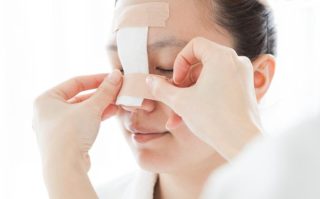


A broken nose’s typical manifestations include redness, swelling, pain, crunching sound, and change of shape of the nose. Additionally, you might experience a blocked nose that would make breathing out challenging. Your physician might gently press on your nose’s sides and surrounding areas to inspect for signs of obstruction or broken bones. The doctor might use a computerized tomography scan (CT) to check for the severity of the injury to make the appropriate treatment plan and broken nose reconstruction.
Ideally, you seek immediate medical attention to assess the extent of facial trauma because many other structures might be affected apart from the broken nose. Your physician should examine your septum for any damages since a blood clot in this area necessitates urgent treatment. A minor nose fracture does not require serious medical treatment since self-care actions like using pain medications and applying ice on the region can suffice. However, a displacement or break will need serious medical attention from an ear nose and throat doctor LA or surgery.
An ear nose and throat doctor LA will manually realign the displaced cartilage and bones in your nose. The physician should carry out the procedure not more than 14 days after the occurrence of the fracture. A broken nose repair in Los Angeles might involve administering drugs through nasal spray or injection to relieve discomfort and the use of specialized equipment to realign cartilage and broken bones. During the procedure, the nostrils are opened by a nasal speculum and splint it through dressing it outside.
Specialists for a broken nose repairs can place an internal split for a short term apart from packing the nose for about seven days. Your physician will provide you with an antibiotic regimen to prevent a bacterial infection from those populating the nose.
Patients with a severe break or multiple nose breaks fail to become eligible candidates for a manual realignment. Additionally, patients with a broken nose that involves the displacement of nasal cartilage or bones and fail to receive therapy within the first 14 days can correct the problem by visiting a nasal fracture reconstruction. A break that damages your nasal septum would cause breathing difficulty or obstruction, which calls for surgery from Los Angeles nasal trauma rhinoplasty physicians.
Nose surgery to correct a break is performed on a patient, and they are released on the same day. Nasal trauma rhinoplasty surgeons in LA realign the nose through a rhinoplasty technique while repairing damaged nasal septum occurs via septorhinoplasty. LA Nasal fracture reconstruction is a closed reduction surgical procedure to administer a local anesthetic to desensitize the nose and realign it manually. These surgical procedures should be performed when there is reduced inflammation that occurs between three and ten days after the break.
Patients should expect discomfort and pain due to the break to subside after surgery for nasal fracture reconstruction in Los Angeles. Most broken noses heal without encountering any problems. However, suppose you are not satisfied with the final look of your nose or experience breathing difficulty. You can seek the services of nasal surgeons to correct it.
Individuals at high risk of getting a nasal break include people engaged in sports such as football and rugby, snowboarding, fighting, martial arts, boxing, and bicycle riding. Other high-risk people susceptible to nasal fractures include older adults and children due to the fluctuation of bone health and higher fall rates. Therefore, such individuals should be aware of the safety precaution to prevent nasal breaks and what to do in the event it happens. Additionally, they should know about the home remedies and lifestyle changes that can keep them safer and prevent having a crooked nose.
It would be best if you acted quickly on your first break by breathing through the mouth and leaning forward to minimize blood draining into the throat. Apply cold compresses or ice packs promptly on the injury not less than four times a day to lessen swelling for the first two days. Each cold compress should last more than 10 minutes to be effective. You should avoid applying excessive pressure or placing the ice directly on the injury because it can lead to further nose damage and pain. Ice should be wrapped around a cloth to avoid frostbite and skin damage.
You can relieve pain from the nose fracture by taking over-the-counter drugs designed for pain control such as ibuprofen, naproxen sodium, and acetaminophen. Non-steroidal anti-inflammatory drugs (NSAIDs) such as ibuprofen prevent inflammation and control fever apart from relieving pain. If acetaminophen and NSAIDs are not helping alleviate the pain, your doctor can prescribe for you a more potent pain reliever.
It would be best if you elevated your head to prevent the worsening of throbbing and swelling of the injury site, especially when sleeping. You should avoid contact activities and sports such as boxing and martial arts after the nose injury for not less than six weeks or at least two weeks for other sports like hockey and basketball after receiving treatment.
Health practitioners advise high-risk individuals such as older adults and children to wear shoes with an excellent grip to prevent falls. Athletes who engage in contact sports such as boxing are advised to adorn protective face gear to avoid nose injuries. Individuals riding bicycles, motorcycles, skis, snowboards, and skateboards are recommended to wear helmets to avoid breaking their noses. Furthermore, you should wear a seat belt when riding or driving a vehicle, and you should make sure kids are adequately restrained to prevent nasal fractures.
Parents can minimize falls at home by encouraging kids to walk barefoot while playing indoors and on natural surfaces such as sand outside the house. If you are a parent, you should caution your child about running or walking on wet surfaces to prevent traumatic facial injuries when they fall. Additionally, you can provide anchorage on walls, cabinets, stairs, and bookshelves apart from throwing away rugs to make kids trip. Contact our ENT doctor in Los Angeles today!